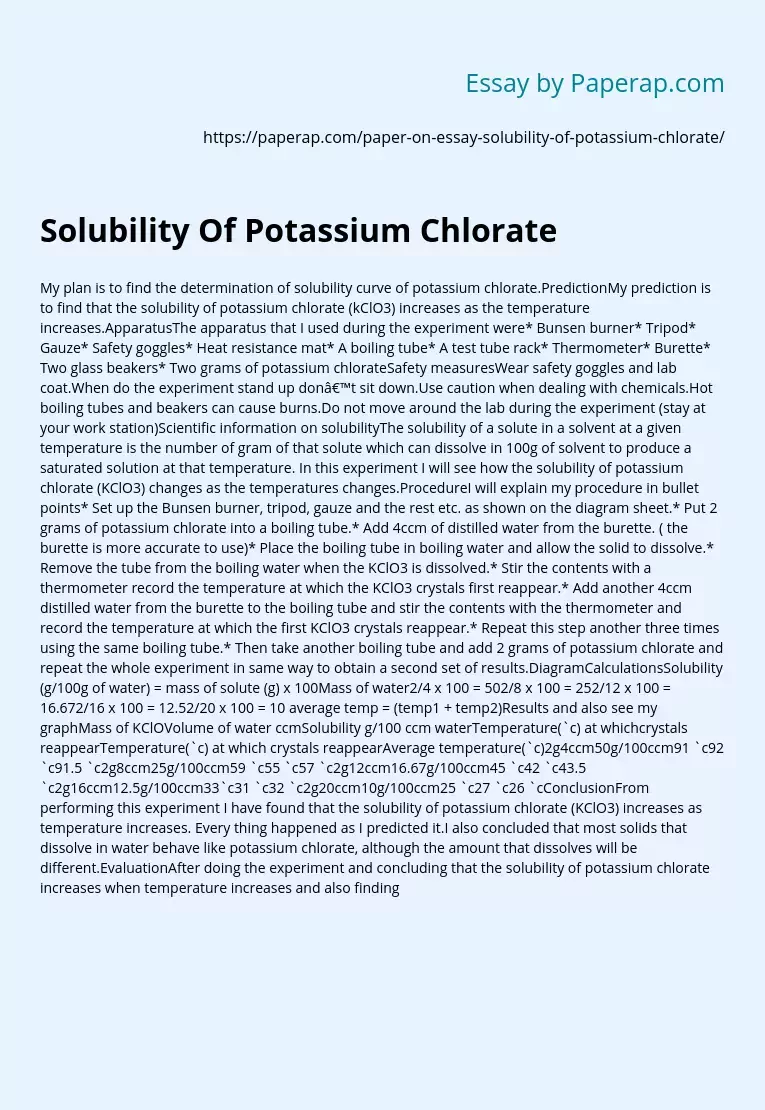Solubility Of Potassium Chlorate
My plan is to find the determination of solubility curve of potassium chlorate.PredictionMy prediction is to find that the solubility of potassium chlorate (kClO3) increases as the temperature increases.ApparatusThe apparatus that I used during the experiment were* Bunsen burner* Tripod* Gauze* Safety goggles* Heat resistance mat* A boiling tube* A test tube rack* Thermometer* Burette* Two glass beakers* Two grams of potassium chlorateSafety measuresWear safety goggles and lab coat.When do the experiment stand up don’t sit down.
Use caution when dealing with chemicals.Hot boiling tubes and beakers can cause burns.Do not move around the lab during the experiment (stay at your work station)Scientific information on solubilityThe solubility of a solute in a solvent at a given temperature is the number of gram of that solute which can dissolve in 100g of solvent to produce a saturated solution at that temperature. In this experiment I will see how the solubility of potassium chlorate (KClO3) changes as the temperatures changes.
ProcedureI will explain my procedure in bullet points* Set up the Bunsen burner, tripod, gauze and the rest etc. as shown on the diagram sheet.* Put 2 grams of potassium chlorate into a boiling tube.* Add 4ccm of distilled water from the burette. ( the burette is more accurate to use)* Place the boiling tube in boiling water and allow the solid to dissolve.* Remove the tube from the boiling water when the KClO3 is dissolved.* Stir the contents with a thermometer record the temperature at which the KClO3 crystals first reappear.
* Add another 4ccm distilled water from the burette to the boiling tube and stir the contents with the thermometer and record the temperature at which the first KClO3 crystals reappear.* Repeat this step another three times using the same boiling tube.* Then take another boiling tube and add 2 grams of potassium chlorate and repeat the whole experiment in same way to obtain a second set of results.DiagramCalculationsSolubility (g/100g of water) = mass of solute (g) x 100Mass of water2/4 x 100 = 502/8 x 100 = 252/12 x 100 = 16.672/16 x 100 = 12.52/20 x 100 = 10 average temp = (temp1 + temp2)Results and also see my graphMass of KClOVolume of water ccmSolubility g/100 ccm waterTemperature(`c) at whichcrystals reappearTemperature(`c) at which crystals reappearAverage temperature(`c)2g4ccm50g/100ccm91 `c92 `c91.5 `c2g8ccm25g/100ccm59 `c55 `c57 `c2g12ccm16.67g/100ccm45 `c42 `c43.5 `c2g16ccm12.5g/100ccm33`c31 `c32 `c2g20ccm10g/100ccm25 `c27 `c26 `cConclusionFrom performing this experiment I have found that the solubility of potassium chlorate (KClO3) increases as temperature increases. Every thing happened as I predicted it.I also concluded that most solids that dissolve in water behave like potassium chlorate, although the amount that dissolves will be different.EvaluationAfter doing the experiment and concluding that the solubility of potassium chlorate increases when temperature increases and also finding that other solids behave like this I feel that the experiment was successful. By using accurate apparatus like the burette and thermometer I believe that I have obtained reliable results. By also repeating to get a second set of results and finding the averages has also made my results reliable. From the graph I can clearly see it is a solubility curve as is should have drawn a line of best fit to suit my results.There are also other experiments that could be done to obtain results for the solubility of potassium chlorate and surely the same conclusion would be drawn up. But I think that the experiment I did was not so accurate but reliable enough.
Essay Example on Soft Skill
Solubility Of Potassium Chlorate. (2019, Nov 27). Retrieved from https://paperap.com/paper-on-essay-solubility-of-potassium-chlorate/

